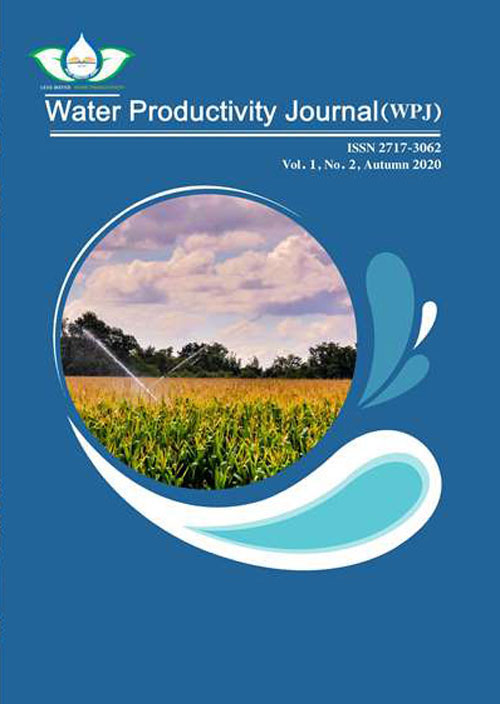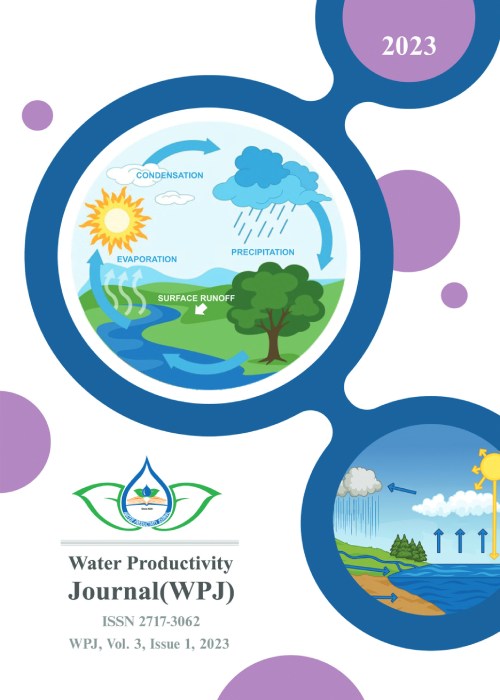فهرست مطالب

Water Productivity Journal
Volume:1 Issue: 4, Spring 2021
- تاریخ انتشار: 1400/03/27
- تعداد عناوین: 7
-
Assessment of Equity in Water Distribution at Watercourse Level and Its Impact on Water ProductivityPages 1-12The impacts of water variation differ in their magnitude in different canal irrigation systems, mainly due to variations in water availability (timings and amounts), crop types and soil fertility status. These necessitates conducting site-specific research and studies to evaluate the impact of variations in water availability at the farm level for specific crops. The findings of such studies will then be utilized to rationalize the irrigation supplies at the farm level keeping in view the level of variation. Accordingly, this study was undertaken for the assessment of inequality in canal water distribution and its impacts on the yield and water productivity of maize in the command area of the Khikhi distributary, Pakistan. For this purpose, three water courses at the head, middle and tail reaches of the distributary were selected. On each of the selected watercourse, three maize fields at the head, middle and tail were chosen. Discharges measurements were taken and the yield of the maize crop was recorded. A significant variation in design and measured discharges were observed in the head reaches (inlet point) of watercourses off taking from the head, middle and tail of distributary that was 13.79%, 12.0% and 7.30% reduction in the flow against the allocated discharges, respectively. The discharge variation along the distributary varies from 0 to 38% from head to tail end, similarly, the variation in discharge for the watercourse located at the head of the distributary was from (100 %) 2.90 cfs to (85.86 %) 2.49 cfs i.e. 0.41 cfs (14.14%) reduction in discharge from head to tail end and for the watercourses located at the middle (WCM) and tail (WCT) the discharge reduction was (31.72%) 1.02 cfs and (37.08 %) 0.66 cfs, respectively. These variations in discharge ultimately reduced the maize crop yield and production from 11 to 54%. The percentage gap in yield from head to tail was up to 54% and the water productivity decreased up to 26% for tail end section of watercourses. These results clearly showed the inconsistency in canal water distribution at tertiary level (watercourse) as well as secondary (distributary) irrigation system leading to reduce the crop production of tail end farmers.Keywords: Canal Water Distribution, Irrigation system, Khikhi Distributary, Water Course, Water distribution, Water productivity
-
Pages 13-24This study determines the effects of variations in relative water supply (RWS) on bean and wheat crop water productivity (WP) under irrigation in Block C at Nyanyadzi irrigation scheme in Zimbabwe. Water supply, bean and wheat crop yield data spanning 17 cropping seasons from 1970 to 2003 were obtained from the irrigation scheme files. Research findings show a weak and significant (R2=0.448, p = 0.006) quadratic relationshipbetween bean WP and RWS. Whereas, for the wheat crop, the relationship WP and RWS is a linear and significant (R2 = 0.438, p = 0.004). Based on the research findings, the study recommends the measures to improve water supply and therefore, crop production. These include among others, switching to more drought tolerant crop varieties that require less water, rainfall harvesting, water conservation measures to retain soil water and, use of more efficient water application methods.Keywords: Crop Water, Irrigation Performance, Nyanyadzi Irrigation Scheme, Relative Water Supply, Water productivity
-
Pages 25-42
Coastal aquaculture is the most productive export earning sectors of Bangladesh. South-Eastern coast of Bangladesh is the most productive region of coastal aquauculture and millions of people depend on this sectors for livelihood. Three categories of tidal water exchange system based ponds of canal connected, river connected and pond connected pond were selected to study the nutrient loading and existing health management in the shrimp ponds. The aims of the study were quantified the hydrology of ponds, health evaluation test with the gut content investigation of shrimp body and nutrient loading from the shrimp ponds. It was found that higher nutrient load in the river connected pond also carried the higher growth and survival rate, feed conversion ratio and the highest production of shrimp. Although unplanned expansion and slightly improved traditional system of shrimp culture exists there is still no risk of environmental degradation in the aquatic environment of shrimp farming in Cox’s bazaar region. It was concluded that reuse water or connected pond system for coastal shrimp ponds should not be practiced anywhere in Bangladesh, due to the uncertainity associated with water productivity in such regions.
Keywords: Coastal Quaculture, growth rate, Nutrient Load, Soil quality, Water productivity, Water Quality -
Pages 43-52In view of high population growth and water resources deficit in arid and semiarid area and groundwater resources shortage in mountainous area, there is an urgent need to identify the alternative sources of potable water. Fog is one of such sources of water. Although fog water yielding potential is largely ignored by water authorities, it was used extensively in ancient times and promoted the water productivity. The objective of this research is to review the fog collection in Yemen and South Africa. In El Tofo Mountain in Chagungo (Chile), 75 fog collectors were erected. According to the reports, production rates vary from zero on a clear day to maximum of 100000 liter per day. With this arrangement, each of the 330 villagers received about 33 liter of clean water per person per day. Geographical and climate characteristics, droplets distribution, and fog density need to be evaluated and are crucial factors for success of fog water harvesting project. Chemical and microbial studies of fog water harvesting show that the water quality is safe for human consumption. Thus, it can be considered as an alternative source of water in arid and semi-arid regions that dense fog could be available.Keywords: Fog Water, Traditional Water System, water harvesting, Water productivity, Water Resources Management
-
Pages 53-66The Organisation for Economic Co-operation and Development (OECD) have predicted from the years 2000 to 2050 the industrial demand for water will increase by 400 %. This manuscript will discuss water stewardship as an aid to water productivity. The benefits of the integration of water stewardship and water productivity will be portrayed in this paper. The fundamentals of water productivity will be outlined. The stages of water stewardship namely operational, context, strategy and engagement will be introduced. The concept of the green economy and ecolabel products will be discussed. Other synergies including the life cycle analysis, water footprint assessment, multibarrier designs, citizen science and policy development as core needs within the integration will be outlined. The bigger goal of aiding the sustainable development goals (SDGs) to achieve clean water and water security as the main reason for society and corporate business to move in the direction of this integration will be highlighted. Water hydrology and catchment understanding are also the core benefits of the integration of water stewardship with water productivity. Improving water productivity by integrating water stewardship into its practices can improve business practices, environmental water flows, supply chain sourcing, policies, and water-efficient technologies. This manuscript highlights the range of different synergies that can strengthen the integration of water stewardship and water productivity. Water stewardship as an aid to water productivity can place water as a game changer for more eco-economical and environmental practices.Keywords: Sustainability, Water productivity, Water security, Water Stewardship
-
Pages 67-74Texas ranks third in the United States in both agricultural acres irrigated and irrigation water applied. Significant advances have been made in irrigation efficiency and water productivity.; however, some challenges remain. The agricultural sector responds to change, and farmers and ranchers have demonstrated resiliency by adapting to the changes in water supply, cost, and regulations. Projections in the 1970s suggested that the Ogallala Aquifer would be exhausted by the early 2000s, but the farmers responded by using newly developed efficient technologies, and the projection did not come true. Opportunities remain for continued improvements in water use efficiency, including: 1) Improving irrigation scheduling, 2) Adopting drought tolerant crop varieties, 3) Developing Improved Irrigation Water Management Technologies, 4) Continued Adoption of Conservation Practices and 5) Improving Irrigation Conveyance Systems. The sustainability of the Southern High Plains (SHP) region in Texas is heavily dependent on the groundwater production from Ogallala Aquifer for crop production. The case study presented here illuminates the existing potential for alternative groundwater sourcing from brackish form. The major aquifer, Ogallala Formation, overlies the minor Dockum Hydrostratigraphic Unit (Dockum-HSU) in much of the Texas Panhandle and West Texas. The brackish groundwater resources from Dockum-HSU can serve as an important alternative source of water to the rapidly depleting Ogallala aquifer. However, water quality and the aquifer physical properties can limit the direct use from the deep Dockum-HSU.Keywords: Groundwater, Irrigation Water Management, Texas, Water productivity, Water Use Efficiency
-
Pages 75-85
The production of drinking water enters a crucial phase as soon as the sources of contamination multiply and extractions increase. Numerous studies have looked at limnic reserves with a strong heritage character, often used to meet the drinking water needs of communities. They highlight the state of degradation of the water bodies and the need to restore them urgently and enhance the water productivity. Most of them focused on the trophic status of the water bodies, the excess of nutrients and chemical inputs of agricultural origin, whose origin remains local. Analyses of water quality have shown relatively high levels of heavy metals (40 - 100 μg/l), casting doubt on the actions taken to collect waste on the scale of local catchment areas. Contents in the sediments fluctuate between 50-100 μg/g, of which a significant proportion is diluted in the interstitial (pore) water. All Alpine and Jura water bodies show traces of metals since the end of the 19th century. The concentrations recorded in the waters of the Jura lakes are of the order of 3-10 μg/g at the surface and can reach 20-35 μg/g at depth, particularly during the stratification period, making the hypolimnion highly anoxic (oxygen content < 2-5%) and a pH slightly below 7. Almost all the water bodies in the Alps and the Jura are directly affected by the consequences of these malfunctions, in particular, those caused by industry (foundries, coal mining), releasing metal emissions, thus affecting the quality of the water and sediments of these fragile reserves. The levels of certain heavy metals recorded in two lakes in the French Jura (Maclu and Saint-Point) confirm the findings of numerous studies on other lakes, highlighting the remote origin of emission sources outside the catchment areas.
Keywords: Eutrophication, Water Productivity, Heavy Metals, Jura, Lakes, nutrient, Sediment, Watershed


